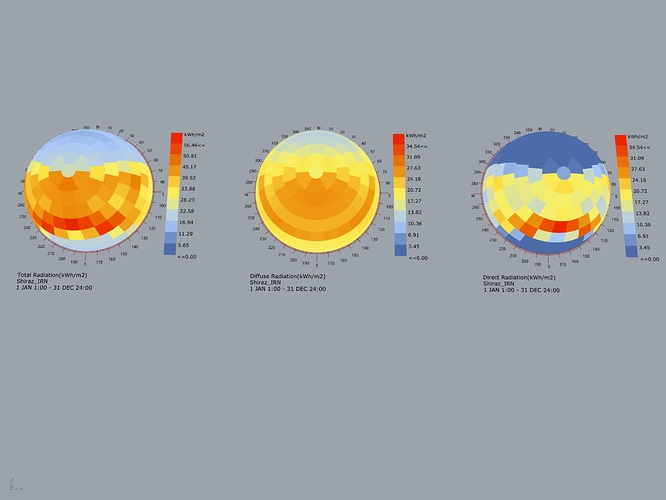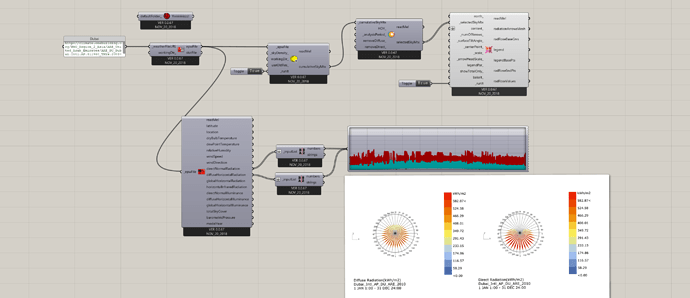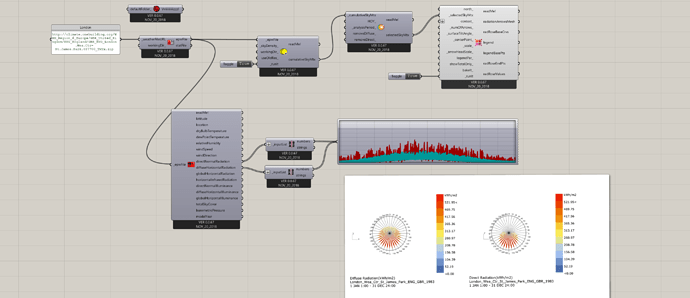hi all
i have 2 .epw for a one city.
one .epw was downloaded from ladybug and another from energyplus.
in this way, when i change my .epw file
my results have many changes.
how can i find which one is more correct?
Ladybug doesn’t have a weather data-set. If by Ladybug you mean epwmap it is just an interface for EnergyPlus Weather data and OneClimate.
You have to compare them with some local measurement. From what I can see the first one represents a mostly direct sky and the second one is a mostly cloudy sky. Which one would you expect to be the case?
Also in the second sky the highest direct radiation happens when the sun is lower in the sky. That is odd and should raise a flag on the accuracy of the data.
Dear @mostapha i agree with you but results show direct radiation is less than diffuse radiation.
i don’t like to annoy you, just i have 1 question,
when you’d written this part of program, did you compare diffuse radiation (NO TOTAL RADIATION) value with other experimental study? or other software? ( I can’t judge about total but i can about direct, you can consult with some university professor, if a city has 270 sunny days, its impossible that annual direct value on horizontal surface be less than diffuse)
Best
I agree with you but let’s see why you get this result from your weather file.
Let’s start from a city that we know is sunny. Say Dubai. Here is what radiation rose and values for Dubai looks like:
The values from weather file shows that the hourly direct normal irradiance values (red) are higher than diffuse horizontal irradiance during the most of the year. The radiation rose also shows that direct contribution is higher than diffuse. This is what we expected to happen.
Now let’s move to another city which we know is cloudy for most of the time. What about London?
As expected the sky is more diffuse. You can see the irradiance is changes during the year and is lower in winter versus summer unlike Dubai which was mostly the same during the year. Radiation-rose also matches the values.
So now let’s try your weather file for Shiraz:
Can you see how the data from weather file does not make any sense? Here is why you get more diffuse radiation than direct. I hope this clarifies the issue.
Yes.
Hi
Dear @mostapha
Like as you know,
GlobalHorizontalRadiation=DiffuseHorizontalRadiation + DirectHorizontalRadiation (NO direct normal radiation DNR)
on the any horizontal surface, if the sky is clear,
DirectHorizontalRadiation must be more than DiffuseHorizontalRadiation.
Did you assume sky is clear?
I don’t agree. If you read the tool tip on the globalHorizontalRadiation output on the importEPW component you’ll find that it is the total of diffuseHorizontal & directNormal.
Dear @devang
like as you know, " Solar Engineering of Thermal Process’" was written by John A. Duffie and et.all is the most reliable book in the solar field.
tool tip is not a valid reference for all university, for more information you can refer to Duffie book.
whenever sun is perpendicular on the surface, we have direct normal radiation, this position just happen for tilted surface no horizontal surface. and whenever we draw sun vector to a horizontal surface, it is called direct or beam horizontal surface.
for more information, we can solve Duffie book Example 2.8.2 chapter 2 page 70
Thanks for the reference Ahad. Appreciate it. I think you would be interested in the following discussion.





